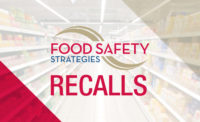A European Union (EU) decision made in 2014 hurt cocoa growers 5,000 miles away. It’s a story that reveals why exporters must monitor changing contaminant standards if they want to keep their export markets.
Seven years ago, the EU ignored its own assessment concluding there was no significant risk from dietary exposure to cadmium and in turn adopted highly restrictive limits of cadmium in cocoa and chocolate products. Some Latin American cocoa has relatively high levels of cadmium because it is grown in volcanic soil, meaning the EU’s new standard jeopardized the export of these products.
Access to the EU is vital to cocoa farmers as it is not only a large consumer market for cocoa-based products, but also because Europe is where a significant amount of the world’s chocolate is produced.
The feared loss of market materialized. Peruvian cocoa exports to the EU declined by nearly a third, Peruvian statistics show an even larger decline over the last five years. The market loss affected 40,000 families, nearly half of the country’s cocoa growers.
Contaminants are unique among the substances regulated in food because often they are naturally occurring and serve no function. Since some can be toxic at elevated levels, there is international agreement that the presence of contaminants should be regulated. A joint United Nations Food and Agriculture Organization and World Health Organization committee (JECFA) comprised of scientists from around the world regularly evaluates human exposure data so safe levels for contaminants can be set. This process works, until it doesn’t, and in the case of cadmium in cocoa it did not work. There are a few reasons why.
First, there was no international level for cadmium in chocolate. World Trade Organization member countries are obligated to base their food safety standards on an international standard unless its own scientific risk assessment comes to a different evidence-based conclusion. In this case, there was no international standard to defer to, but what is worse, and the second reason the case of cadmium and cocoa is complicated, is the EU did not base its standard on a known risk. Under international agreement, whether internationally or domestically set, a standard must be based on a known risk. A hypothetical risk is not enough to justify a standard.
Within months of the EU’s action, Colombia requested an international evaluation of cadmium in cocoa and chocolate. At first, things followed the typical process. Scientific evaluations were provided to the Codex Committee on Contaminants in Food (CCCF) by JECFA. These scientists assessed the risk that cadmium in cocoa presented to human health and concluded that the natural levels of cadmium in cocoa and chocolate were not of concern. Normally, that would have settled the matter, but what the EU did next was not normal, and hit South American cocoa farmers.
When the data led the CCCF to consider cadmium maximum levels that were much higher than what the EU had adopted, the EU refused to support any values that were higher than its own. Since Codex operates on consensus, the objection of a single member can prevent a measure’s adoption. The EU’s intransigence prevented Codex from fulfilling its mission of establishing an international, science-based standard.
It was feared the continued absence of an international standard could have ramifications beyond the European market. When there are such gaps, some countries setting standards refer to nations with well-developed food safety regulations. However, food safety leaders such as Canada, Japan, and the U.S. regulate contaminants less actively than they do pesticides and food additives. This can leave the European Union standard as the benchmark in the absence of an international standard. That is only a problem if the EU sets a non-scientific standard and then blocks a science-based international standard from being adopted, which is what happened.
After years of gridlock, in 2019 a compromise was brokered for a cadmium maximum level of 0.3 mg/kg in milk chocolate and other low-cocoa products. Still, it was likely that 12 percent of some Latin American cocoa exports would not meet this level, but a 12 percent rejection rate was better than the nearly 40 percent that could have been rejected under the EU’s supported level of 0.1 mg/kg. Remarkably, the EU then withdrew its support for the compromise level and objected to it at the final step of the approval process. The standard was sent back to the CCCF. In May 2021, the cadmium level for milk chocolate and other low-cocoa products was again approved by the CCCF at the compromise value of 0.3 mg/kg. This standard now heads to the full Codex Alimentarius Commission for final adoption. There, in November 2021, the EU’s commitment to international, science-based standard-setting will again be tested.
The quick response and steady resolve of the Latin American countries at Codex is only a partial victory. The compromise standard, while less onerous, is not entirely risk-based and will restrict trade more than is necessary to protect human health. What’s worse, as feared, in the absence of an international standard other countries, such as Egypt, Switzerland, and Turkey are adopting the EU levels. The Gulf Cooperation Council and Israel have proposed to do the same.
Securing the new cadmium/cocoa international standards in November is critical if certain Latin American cocoa growers are to keep their export market share. Countries other than the EU are revising their contaminant regulations. From late 2019 through September 2021, Brazil, Hong Kong, Singapore, Thailand, Taiwan, and Ukraine, among others, have all issued revised contaminant standards for raw commodities and processed food and beverages.
To protect hard-earned markets, exporters must ensure they monitor proposed, pending, and new contaminant maximum levels related to their products. Then, armed with this knowledge, challenge proposals that are not risk-based and violate international standards agreements. This requires vigilance and persistence, but the alternative is risking continued access to hard-earned markets.



